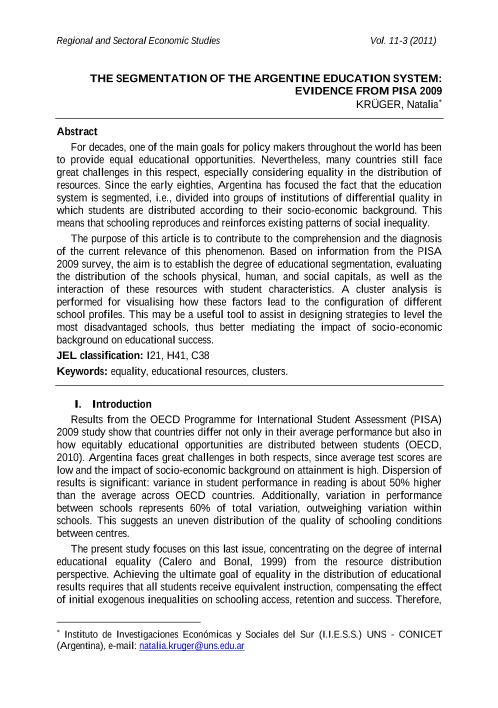Artículo
The segmentation of the argentine education system: evidence from PISA 2009
Fecha de publicación:
07/2011
Editorial:
Euro-American Association of Economic Development
Revista:
Regional and Sectoral Economic Studies
ISSN:
1578-4460
Idioma:
Inglés
Tipo de recurso:
Artículo publicado
Clasificación temática:
Resumen
For decades, one of the main goals for policy makers throughout the world has been to provide equal educational opportunities. Nevertheless, many countries still face great challenges in this respect, especially considering equality in the distribution of resources. Since the early eighties, Argentina has focused the fact that the education system is segmented, i.e., divided into groups of institutions of differential quality in which students are distributed according to their socio-economic background. This means that schooling reproduces and reinforces existing patterns of social inequality. The purpose of this article is to contribute to the comprehension and the diagnosis of the current relevance of this phenomenon. Based on information from the PISA 2009 survey, the aim is to establish the degree of educational segmentation, evaluating the distribution of the schools physical, human, and social capitals, as well as the interaction of these resources with student characteristics. A cluster analysis is performed for visualising how these factors lead to the configuration of different school profiles. This may be a useful tool to assist in designing strategies to level the most disadvantaged schools, thus better mediating the impact of socio-economic background on educational success.
Palabras clave:
EQUALITY
,
EDUCATIONAL RESOURCES
,
CLUSTERS
Archivos asociados
Licencia
Identificadores
Colecciones
Articulos(IIESS)
Articulos de INST. DE INVESTIGACIONES ECONOMICAS Y SOCIALES DEL SUR
Articulos de INST. DE INVESTIGACIONES ECONOMICAS Y SOCIALES DEL SUR
Citación
Krüger, Natalia Soledad; The segmentation of the argentine education system: evidence from PISA 2009; Euro-American Association of Economic Development; Regional and Sectoral Economic Studies; 11; 3; 7-2011; 41-64
Compartir




